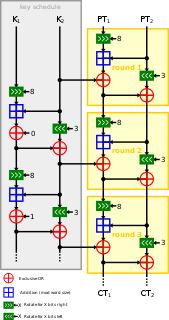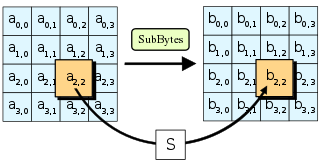The Session Initiation Protocol (SIP) is a signaling protocol used for initiating, maintaining, and terminating real-time sessions that include voice, video and messaging applications. SIP is used for signaling and controlling multimedia communication sessions in applications of Internet telephony for voice and video calls, in private IP telephone systems, in instant messaging over Internet Protocol (IP) networks as well as mobile phone calling over LTE (VoLTE).
Symmetric-key algorithms are algorithms for cryptography that use the same cryptographic keys for both encryption of plaintext and decryption of ciphertext. The keys may be identical or there may be a simple transformation to go between the two keys. The keys, in practice, represent a shared secret between two or more parties that can be used to maintain a private information link. This requirement that both parties have access to the secret key is one of the main drawbacks of symmetric key encryption, in comparison to public-key encryption.
In cryptography, a block cipher mode of operation is an algorithm that uses a block cipher to provide information security such as confidentiality or authenticity.
A block cipher by itself is only suitable for the secure cryptographic transformation of one fixed-length group of bits called a block. A mode of operation describes how to repeatedly apply a cipher's single-block operation to securely transform amounts of data larger than a block.
In computing, an interface is a shared boundary across which two or more separate components of a computer system exchange information. The exchange can be between software, computer hardware, peripheral devices, humans, and combinations of these. Some computer hardware devices, such as a touchscreen, can both send and receive data through the interface, while others such as a mouse or microphone may only provide an interface to send data to a given system.
In cryptography, a related-key attack is any form of cryptanalysis where the attacker can observe the operation of a cipher under several different keys whose values are initially unknown, but where some mathematical relationship connecting the keys is known to the attacker. For example, the attacker might know that the last 80 bits of the keys are always the same, even though they don't know, at first, what the bits are. This appears, at first glance, to be an unrealistic model; it would certainly be unlikely that an attacker could persuade a human cryptographer to encrypt plaintexts under numerous secret keys related in some way.
The MicroBlaze is a soft microprocessor core designed for Xilinx field-programmable gate arrays (FPGA). As a soft-core processor, MicroBlaze is implemented entirely in the general-purpose memory and logic fabric of Xilinx FPGAs.
CCM mode is a mode of operation for cryptographic block ciphers. It is an authenticated encryption algorithm designed to provide both authentication and confidentiality. CCM mode is only defined for block ciphers with a block length of 128 bits.

VEST ciphers are a set of families of general-purpose hardware-dedicated ciphers that support single pass authenticated encryption and can operate as collision-resistant hash functions designed by Sean O'Neil, Benjamin Gittins and Howard Landman. VEST cannot be implemented efficiently in software.

Trivium is a synchronous stream cipher designed to provide a flexible trade-off between speed and gate count in hardware, and reasonably efficient software implementation.
EAX mode (encrypt-then-authenticate-then-translate) is a mode of operation for cryptographic block ciphers. It is an Authenticated Encryption with Associated Data (AEAD) algorithm designed to simultaneously provide both authentication and privacy of the message with a two-pass scheme, one pass for achieving privacy and one for authenticity for each block.
Galois/Counter Mode (GCM) is a mode of operation for symmetric-key cryptographic block ciphers that has been widely adopted because of its efficiency and performance. GCM throughput rates for state-of-the-art, high-speed communication channels can be achieved with reasonable hardware resources. The operation is an authenticated encryption algorithm designed to provide both data authenticity (integrity) and confidentiality. GCM is defined for block ciphers with a block size of 128 bits. Galois Message Authentication Code (GMAC) is an authentication-only variant of the GCM which can be used as an incremental message authentication code. Both GCM and GMAC can accept initialization vectors of arbitrary length.
Dolby E is an audio encoding and decoding technology developed by Dolby Laboratories that allows 6 to 8 channels of audio to be compressed into an AES-EBU digital audio stream that can be stored as a standard stereo pair of digital audio tracks.
There are various implementations of the Advanced Encryption Standard, also known as Rijndael.
A new mode called Sophie Germain Counter Mode (SGCM) has been proposed as a variant of the Galois/Counter Mode of operation for block ciphers. Instead of the binary field GF(2128), it uses modular arithmetic in GF(p) where p is a safe prime 2128 + 12451 with corresponding Sophie Germain prime p − 1/2 = 2127 + 6225.
SGCM does prevent the specific "weak key" attack described in its paper, however there are other ways of modifying the message that will achieve the same forgery probability against SGCM as is possible against GCM: by modifying a valid n-word message, you can create a SGCM forgery with probability circa n/2128. That is, its authentication bounds are no better than those of Galois/Counter Mode. SGCM when implemented in hardware has a higher gate count than GCM. However, its authors expect software implementations of SGCM to have similar or superior performance to GCM on most software platforms.

Speck is a family of lightweight block ciphers publicly released by the National Security Agency (NSA) in June 2013. Speck has been optimized for performance in software implementations, while its sister algorithm, Simon, has been optimized for hardware implementations. Speck is an add–rotate–xor (ARX) cipher.
The tables below compare cryptography libraries that deal with cryptography algorithms and have API function calls to each of the supported features.

Hardware-based encryption is the use of computer hardware to assist software, or sometimes replace software, in the process of data encryption. Typically, this is implemented as part of the processor's instruction set. For example, the AES encryption algorithm can be implemented using the AES instruction set on the ubiquitous x86 architecture. Such instructions also exist on the ARM architecture. However, more unusual systems exist where the cryptography module is separate from the central processor, instead being implemented as a coprocessor, in particular a secure cryptoprocessor or cryptographic accelerator, of which an example is the IBM 4758, or its successor, the IBM 4764. Hardware implementations can be faster and less prone to exploitation than traditional software implementations, and furthermore can be protected against tampering.





